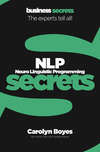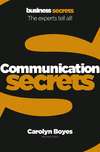Loe raamatut: «NLP»
Collins Business Secrets – NLP
Table of Contents
Cover Page
Title Page
Learn how to use NLP in business
Take responsibility
1.1 Be ‘at cause’
1.2 Know your map
1.3 Look below the surface
1.4 Recognize your preferred sense
1.5 Discover your beliefs
1.6 Identify your business values
1.7 Be observant
Focus on your outcomes
2.1 Have well-formed visions
2.2 Don’t just try…DO it
2.3 Commit and take action
2.4 Break old habits
2.5 Use failure as feedback
2.6 Ask questions
2.7 Be specific
Be an excellent communicator
3.1 Establish rapport
3.2 Pay attention
3.3 Watch the eyes
3.4 Don’t mention the blue tree
3.5 Create a positive state
Be a great motivator
4.1 Discover your direction
4.2 Know the reason why
4.3 Be convincing
4.4 Reward interests
4.5 Offer the right sized chunks
4.6 Separate externals from internals
4.7 Manage mismatchers
4.8 Respect values
Boost your performance
5.1 Believe in yourself and other people
5.2 Change your perspective
5.3 Change your negative thoughts
5.4 Change the frame
5.5 Anchor positive feelings
5.6 Change your language
5.7 Respond positively to criticism
5.8 Be your own success coach
5.9 Model excellence
Make a powerful impression
6.1 Learn from the masters
6.2 Use stories
6.3 Vary your voice
6.4 Use the 4-Mat system
6.5 Run a great meeting
Sell to anyone
7.1 Know your client
7.2 Ask questions
7.3 Check out what’s important
7.4 Paint a happy future
7.5 Get agreement along the way
7.6 Talk your client’s language
7.7 Handle objections simply
7.8 Use power words
7.9 Watch your ‘buts’!
Jargon buster
Further reading
About the Author
Copyright
About the Publisher
Learn how to use NLP in business
Neuro Linguistic Programming (NLP) is a method used in business to improve performance. It contains techniques that help to change your patterns of thoughts, emotions and behaviour in positive ways. You can use these techniques for yourself, or as a manager with your team.
I first learnt these techniques 15 years ago while I was working in international sales. Immediately I realized how dramatically my performance would improve by applying them in my business work and other parts of my life. I trained first as a practitioner and then as a teacher of NLP. I have since coached and trained hundreds of business people in NLP methods and ways of thinking.
NLP began life in the 1970s as the result of studies at the University of California. Richard Bandler and John Grinder came up with a model of human excellence based on their research into language and behaviour, and the link between mind and body.
NLP has become a powerful tool for improving performance. Some of the benefits I have observed in myself and others are better communication and team skills, overcoming blocks to performance, improved sales, management and leadership skills, greater self-confidence, improved presentation and influencing skills, and the ability to generate clearer goals and achieve them.
This book consists of 50 secrets about NLP, divided into seven chapters.
• Take responsibility. The basic thinking in NLP that allows you to focus on the results you want to get in business.
• Focus on your outcome. How to set a clear desired outcome in order to improve short- and long-term performance.
• Be an excellent communicator. Tools that help you to have better relationships with your colleagues and clients.
• Be a great motivator. Understand how to motivate yourself and others, and achieve more.
• Boost your performance. Overcome barriers and blocks to performance, and increase your personal power in business.
• Make a powerful impression. Increase the impact you make in meetings and at presentations.
• Sell to anyone. How to sell yourself, your products and your ideas successfully inside and outside your organization.
If you follow these 50 secrets, you will have learnt the ways of thinking that allow business leaders to become star business performers. Look forward to boosting your business performance every day and avoid the pitfalls that can hold you back from success.
You can change your results just by changing the way you think.
Take responsibility
The key attitude that underlies the thinking and techniques of NLP is to take charge of what happens to you. Once you decide to take responsibility for your business success you will achieve more of what you want (and less of what you don’t want). When you don’t get the result you want quickly, you’ll find it easier to uncover the block and know what to do about it.
1.1 Be ‘at cause’
“I can’t help being late. All my family are like that.” “I can’t do anything about getting on with my boss. It’s him who always causes the problems.” “I can’t make this business successful, the economy is too bad.” “I can’t stop smoking, I’m addicted to smoking.” “It’s not my fault!”
Everything that happens in life has a cause. Ben eats a big meal. What happens? He puts on weight. Krizia doesn’t eat for two days, and loses weight? It’s simple: the effect of eating too much or too little has been caused by the action of eating too much or too little.
• The Cause: Effect equation. NLP expresses this with the Cause: Effect equation, C:E. Cause is on one side, and Effect is on the other.
one minute wonder Any time you feel unsure about what you are doing, take a minute to think about what you want to achieve. By being clear about the outcome you want, you will soon understand what you need to take responsibility for. This will make you more prepared to be ‘at cause’ in business.
“Always bear in mind that your own resolution to succeed is more important than any other”
Abraham Lincoln, 19th-century US President
What this means is that for every cause there is an effect and for every effect there is a cause.
• Are you at the cause of your life or the effect of your life? In other words, do you take responsibility for what happens to you or do you consider yourself a passive victim?
Losing weight’s a simple example. Take responsibility, exercise more and eat less, and see if you get a different result. Probably you will. Occasionally it gets more complicated, if there’s a medical issue for example, but then you can stay ‘at cause’ by taking medical advice. Now you know how to lose weight again.
But what about my relationship with my boss? Why is it not working? The original cause may not be as obvious. Was it me or him? Or both of us? All you know is that it’s not working. So how do you stay on the cause side of the equation on this one?
Well, at first glance it may not seem an easy situation to change, but in fact it’s very simple. All you have to do to be ‘at cause’ is to take responsibility for the results you get from now on. So what if it was his fault? How about changing your beliefs about the situation and behaving differently towards him? See what happens. Later secrets will give you great tools for doing this.
Decide to be in charge of your business success, and not at the mercy of what happens to you.
1.2 Know your map
In ancient times, sailors set out to explore the world. The maps they drew up look very different to maps made today in the era of satellite navigation. The ancient mariners’ perception of the world was clearly different from ours. Future generations will also have different maps and ideas about the cosmos as technology evolves. This illustrates a central idea of NLP: that a map – and thus our peception of the world – is always subjective.
In other words, each of us has a unique view on the world. How we see the world is not actually how the world is, it’s simply the internal map (or model) we’ve developed – our way of looking at things. Each of us may think we are looking at things as they really are, but the way we think is just a viewpoint. Someone else may think very differently about the same situation.
• The role of the subconscious. Most of the time, how we think about things is subconscious. It has to be, because the conscious mind can focus only on a few things at a time. Subconsciously we take in much more. Our subconscious runs our body, stores our memories and
one minute wonder Always have respect for another person’s view of the world. Just because someone disagrees with you or has different values, that doesn’t mean that they are wrong (or you are wrong) – simply that you have different maps.
takes in information through the senses. We’re bombarded with information – some say two million bits of it per second, whereas consciously we’re only aware of about seven bits of information per second. That’s why our internal map of the world is unique. Without thinking about it, we pay attention to some things more than others.
Once you recognize that your map is a subjective view of the world, you can begin to do two useful things.
1 Firstly, recognize that other people’s views are equally subjective and valid.
2 Secondly, look inside yourself and work out what you are choosing to pay attention to.
Once you start to perceive the things around you that you’ve previously been ignoring, then you have the choice to change your map if your current one isn’t getting you to the destination you want.
If you change the way you think, you’ll change the way you act. If you change the way you act, you’ll change the results you get.
We each have a unique internal map of the external world.
1.3 Look below the surface
All the time you are reading this there is a lot going on below the surface. In the few seconds it has taken you to read this far into Secret 1.3, your subconscious has already been very busy. You weren’t aware of what was going on. So what’s happening?
Your brain acts as a virtual reality machine. As you are reading this Secret you are taking in information through your senses: seeing, hearing, feeling, smelling and tasting. You are probably most aware of your visual sense, but the others are still working hard as well.
The subconscious interprets the information it receives and stores some of it as memories.
one minute wonder Bear in mind that the body and mind are linked. What you think affects what you feel. What you feel affects what happens inside your body and, in turn, your body language and your behaviours which are visible to other people. So how you think ultimately influences how other people react to you.
Three big filters are always being used by the subconscious:
1 Deletion. First of all your subconscious promptly deletes most of the information it receives. That’s why you don’t remember the two million bits of information you are smelling, hearing and feeling as you are reading this. For example, how aware are you of the feeling in your arms or legs? Maybe you are now, but were you a few seconds ago?
2 Distortion. At the same time you continually distort some of the information to store it more easily. For example, while travelling through the countryside you see a pretty cottage, which reminds you of a picture you once saw of a fairytale house made of gingerbread. Later, you don’t remember the exact colour and details of the house, only a sense of it as the fairytale house.
3 Generalization. The subconscious groups information into categories. For example you see someone sitting on something that looks roughly like another object you habitually call a chair. “Hey”, says your subconscious! “That’s useful. I will describe this as a chair as well.” (Even if the object is actually something else.)
Your subconscious always works hard for you, but its habit of distorting, deleting and generalizing all give rise to beliefs and opinions about the world that may not always be useful to you.
What can you do about it? First of all, start paying attention to your beliefs, and actively adopt and emphasize those beliefs that empower rather than limit your business success.
Your subconcious filters bits of information to create your highly personal view of the world.
1.4 Recognize your preferred sense
Each day we experience the world through the five senses. These are known as the Visual, or seeing, sense; the Auditory, or hearing, sense; the Kinesthetic, or touch and feeling, sense; the Olfactory, or smell, sense; and the Gustatory, or taste, sense. People rely on these five senses to different degrees.
We store representations of the outside world inside our subconscious using our senses. This is how a memory can bring back a smell, picture or sound. In NLP the senses are called representational systems.
We each subconsciously use one sense more than the others. Some store memories primarily as images. Others delete more of what they see, and store more sound images. If you subconsciously prefer the visual sense you may be drawn towards visual work. If you’re more sound focused, then you may be especially fascinated by music or language. Or perhaps you prefer touch and feeling, and so favour physical pursuits, such as sport or working with your hands.
Just because you have a preference for one sense over another doesn’t mean that you can’t use all of them. This affects learning differences. If you prefer the visual, you may want visual props when
one minute wonder Be careful how you present information to others in business. Listen to the language the other person is using and use similar language back to them. If you are not sure about someone’s preferred systems, make sure you present in a range of ways to cover different groups. Don’t use only your preferred style.
learning. Auditory learners need to hear information to take it in efficiently. Kinesthetic learners like to try out what they are learning, for example through exercises and role play.
People give away their preferred sense through the words they choose. Use their preferred words and they will relate to you better. For example:
• Visual words. Look, see, clear, bright, sparkling, picture, clarify, perspective, illustrate, focus, colourful, watch, illusion, shine, dim, vivid.
• Auditory words. Noise, hear, resonate, deaf, speak, rhythm, ask, silent, tune, pitch, buzz, audible, earful, remark, tongue-tied, rings a bell.
• Kinesthetic words. Feel, unfeeling, solid, concrete, hit, pressure, hothead, handle, soft, hard, cold, tickle, seize, pressure, get in touch with.
By finding out which senses you and your colleagues individually prefer, you can learn about your different maps of the world, different learning styles and how to communicate more flexibly.
People vary in the way they perceive the world through the different senses.
Tasuta katkend on lõppenud.















